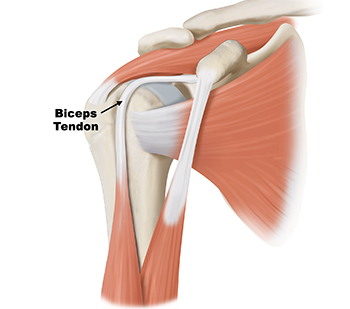Biceps Tendinitis
What is biceps tendinitis?
Biceps tendinitis is inflammation or irritation of the long head biceps tendon. The biceps tendon is made up of two distinct tendons, the short head of the biceps and the long head of the biceps, that connect the biceps muscle to bones in the shoulder and forearm. In particular, the long head of the biceps originates from the glenoid labrum and supraglenoid tubercle of the scapula, which is a bony projection at the top of the shoulder blade. It travels down the front of the upper arm, passing through the shoulder joint and running inside the bicipital groove (intertubercular groove) of the humerus, which is the bone of the upper arm.
Biceps tendinitis is one of the main pain generators from the shoulder. The affected area is where the biceps muscle attaches to the front of the shoulder.

Biceps tendinitis is often the result of repetitive shoulder movements and overuse, leading to microtrauma of the tendon, weakness of the tendon, and surrounding inflammation. However, bone spurs, rotator cuff damage, shoulder instability, osteoarthritis, and trauma also frequently exacerbate this condition. Athletes competing in sports with high shoulder demands, such as baseball pitchers, tennis players, or swimmers; physically active people; and older patients may experience this condition due to shoulder damage and inflammation.
- Intermittent or constant shoulder pain in the front side. This pain may worsen when the patient extends the affected arm out in front of their body (Speed’s test) or when raising the arm above their head.
- Tenderness to touch in the front of the shoulder.
- Weakness
- Swelling
- Popping sensation with arm movement.
- “Popeye” Deformity: Occasionally, damage to the biceps tendon causes a tear or rupture, resulting in a deformity of the upper arm referred to as a “Popeye” deformity.
The combination of a detailed history, comprehensive physical examination, x-rays, and an MRI (magnetic resonance imaging) is the key to a successful diagnosis of biceps tendinitis. Dr. Jorge Chahla and his team use specialty tests as part of the physical exam, including the Speeds and O’Brien’s tests, to properly evaluate and diagnose a biceps tendon Injury. An MRI is an important diagnostic imaging test to evaluate the full extent of the injury and quality of the biceps tendon. The MRI also allows Dr. Chahla to fully assess surrounding shoulder structures, including the superior labrum and rotator cuff.
Biceps tendinitis is an inflammatory condition affecting the long head of the biceps tendon, causing pain, tenderness, and weakness in the front of the shoulder. This condition is common among athletes and individuals who perform repetitive overhead motions. Dr. Jorge Chahla offers advanced diagnostic and treatment solutions for biceps tendinitis, helping patients relieve pain and restore shoulder function. If you have persistent shoulder pain, contact Dr. Chahla’s office in Chicago, Naperville, or Oak Brook for expert evaluation.
At a Glance
Dr. Jorge Chahla
- Triple fellowship-trained sports medicine surgeon
- Performs over 700 surgeries per year
- Associate professor of orthopedic surgery at Rush University
- Learn more

